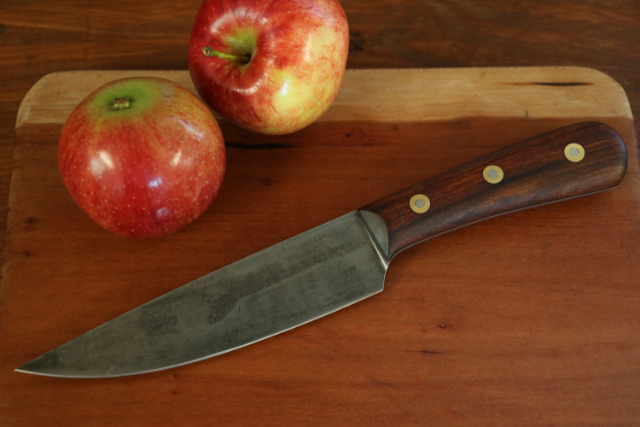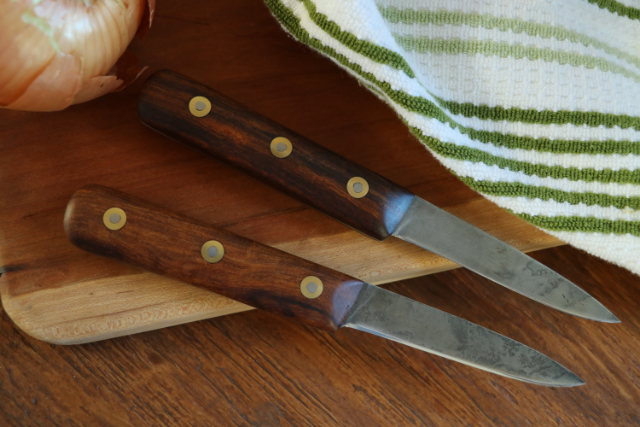Howdy folks! Lucas Forge custom kitchen knives have been extensively tested through real use in real kitchens. They chop, dice, and slice their way to helping to feed our crew every day. Custom kitchen knives are available with stainless steel blades upon special request, but we have found it a true pleasure to use high carbon blades in the kitchen. Let’s talk about it!
 Lucas Forge CK1 Chef’s Knife with ironwood handle, dual toned pins and aged blade finish!
Lucas Forge CK1 Chef’s Knife with ironwood handle, dual toned pins and aged blade finish!
Stainless steel is a very popular choice for kitchen knives…what differences should you expect to encounter if you try high carbon? Where the stainless blades keep their shiny appearance, a high carbon blade will at once begin to develop a patina that is the badge of faithful service. Even if your knife starts with a shiny satin finish, without constant maintenance, it will begin to take on a unique aged-looking finish that changes as you use it! It’s a fascinating experience.
In contrast to a stainless blade, your high carbon kitchen knife will start to rust if left in contact with water. This is sad if you ever happen to leave your knife in a pan of dishwater, put it in a dishwasher, or shove it into a dish drainer. Yikes!
To avoid any rusty situations, wash your knife immediately after use, especially when cutting acidic ingredients, such as pineapple(!), lemons or tomatoes. It’s a great idea to never let your knife leave your hand. This literally becomes second nature. When you get done using your knife, simply rinse the blade under warm water, wash with a soapy dishcloth, rinse again, and – before you put it down – dry your knife and put it away.
Speaking of putting it away, how do you store a Lucas Forge kitchen knife? Around here, we are big fans of flat knife blocks that fit into a drawer. The knife slips into its own slot, ready for action, and safely out of reach of little hands.
 Here are a couple of other tips to keep in mind:
Here are a couple of other tips to keep in mind:
-Use a cutting board and when you scrape what you’re chopping into a bowl or pot, do it with the back of the knife, not the blade. This will preserve your edge longer.
-Protect the tip of your knife by using more blade surface whenever possible. Instead of plunging the blade straight into a hard vegetable, start with the tip, but quickly rock toward the rest of the blade.
-Have a ceramic rod or other sharpening tool handy. Though high carbon blades hold an edge well, the key to keeping them sharp is to not let them get too dull.
-If your knife does happen to be forgotten after being washed and has a small amount of surface rust, don’t panic! Wash your knife again, buffing the area well. After drying, rub a little food-grade oil over the blade and continue using as usual. A little oil is always a great maintenance routine for your knife on occasion!
 A pair of Lucas Forge paring knives, also with ironwood handles, dual toned pins and aged blade finishes!
A pair of Lucas Forge paring knives, also with ironwood handles, dual toned pins and aged blade finishes!
I hope these tips have been helpful. I also hope you, like us, will find high carbon kitchen knives to be pleasurable tools to use in your kitchen. If you are interested in ordering your own chef’s knife, please contact lucas@customhuntingknives.org. Thank you for your interest!
